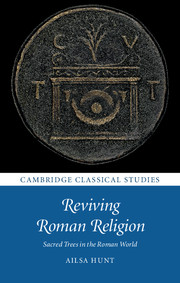Book contents
- Frontmatter
- Dedication
- Contents
- List of figures
- Acknowledgements
- 1 Rooting in: why give time to sacred trees?
- 2 A brief history of tree thinking: the enduring power of animism
- 3 How arboreal matter matters: rethinking sacrality through trees
- 4 Arboriculture and arboreal deaths: rethinking sacrality again
- 5 Confronting arboreal agency: reading the divine in arboreal behaviour
- 6 Imagining the gods: how trees flesh out the identity of the divine
- 7 Branching out: what sacred trees mean for Roman religion
- Appendix
- Bibliography
- Index
6 - Imagining the gods: how trees flesh out the identity of the divine
Published online by Cambridge University Press: 05 September 2016
- Frontmatter
- Dedication
- Contents
- List of figures
- Acknowledgements
- 1 Rooting in: why give time to sacred trees?
- 2 A brief history of tree thinking: the enduring power of animism
- 3 How arboreal matter matters: rethinking sacrality through trees
- 4 Arboriculture and arboreal deaths: rethinking sacrality again
- 5 Confronting arboreal agency: reading the divine in arboreal behaviour
- 6 Imagining the gods: how trees flesh out the identity of the divine
- 7 Branching out: what sacred trees mean for Roman religion
- Appendix
- Bibliography
- Index
Summary
When divine agents expressed themselves through arboreal behaviour, the human world and the world of the divine temporarily overlapped. The startling and unsettling nature of these arboreal portents made getting to grips with their meaning pressingly urgent: as such it is hardly surprising that these portents have quite a noisy presence in the literature of the Roman world. Yet to focus purely on such attention-grabbing moments in the life of a tree is only to scratch the surface of how Romans understood trees, rooted in the human world, to intersect with the world of the divine. Turning now to the more mundane existence of trees, we will find that Roman thinkers envisaged a diverse spectrum of ways in which a tree might stand in relation to a particular deity, as a point of contact between the human world and the world of the divine. Continuing the theme of Chapter 5 – how the divine is articulated and read in the arboreal world – in this chapter I explore how trees fleshed out Roman imagination of the identity of the deities they worshipped.
A striking fresco from the east wall of the calidarium in the villa at Oplontis gives us an idiosyncratic preview of the kind of thinking about trees which will dominate this chapter. Here we find Hercules hugging a tree, around which is tied a large yellow ribbon (Figure 2). Standardly this image is said to be of Hercules in the garden of the Hesperides, but I see no reason to accept this. The one gold shape which some might have seen as a cluster of golden apples is, on close examination, in fact a bird flying close to the tree. Without any apples on the tree, or a snake twisting round it, why see this as the Hesperides' garden? Odd as it may be to us, we should not ignore the fact that what we see here is Hercules embracing a tree. As such this image makes a tantalising contribution to our thinking about the relationships Roman thinkers constructed between trees and deities. Matters are made particularly complicated by Hercules' own ambiguous divine status: are we to imagine this as Hercules the temporarily earth-bound hero, Hercules the deity, or something in between?
- Type
- Chapter
- Information
- Reviving Roman ReligionSacred Trees in the Roman World, pp. 224 - 291Publisher: Cambridge University PressPrint publication year: 2016
- 1
- Cited by



